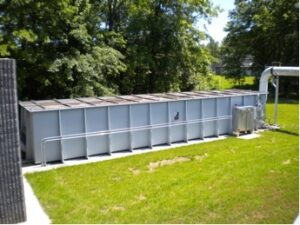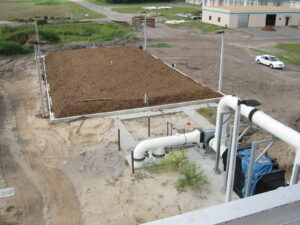How Do Biofilters Work? Breaking Down the Basics for Non-Engineers
 Many wastewater plants, composting sites, and food production facilities struggle with air quality complaints. Neighbors notice odors before they see a facility. In response, more managers are exploring solutions that don’t involve harsh chemicals or complicated systems. Biofilters are one of the most popular options—but not everyone outside of engineering knows how they work.
Many wastewater plants, composting sites, and food production facilities struggle with air quality complaints. Neighbors notice odors before they see a facility. In response, more managers are exploring solutions that don’t involve harsh chemicals or complicated systems. Biofilters are one of the most popular options—but not everyone outside of engineering knows how they work.
At Webster Environmental Associates, we work with clients who are responsible for odor control but may not have a technical background. We’ll explain how biofilters function in everyday settings and why they’ve become such a practical option for long-term odor reduction.
What Is a Biofilter?
A biofilter is an air treatment system that uses living microorganisms to remove odor compounds from air streams. These systems are built to move foul air through a bed of porous media—usually wood chips, compost, or engineered materials. As air passes through the media, odor compounds stick to the surface, where microbes break them down into simpler, harmless materials like carbon dioxide and water.
Biofilters are widely used in wastewater treatment plants, composting operations, and food production facilities. They’re popular because they don’t rely on chemical storage or dosing equipment. With the right design and setup, they’re reliable and cost-effective over time.
How the Microbes Do the Work
The heart of every biofilter is the microbial layer living inside the media. These microbes feed on the industrial odor compounds, which include things like hydrogen sulfide, ammonia, and volatile organic compounds (VOCs). As the air flows through the media bed, those compounds are absorbed, then broken down by the microorganisms.
For this to happen efficiently, the media must stay moist. Microbes also need a balanced pH, steady airflow, and enough oxygen to survive. If conditions become too dry or too acidic, their ability to break down odors decreases. That’s why moisture control and monitoring are key parts of any successful biofilter system.
The Role of Preconditioning
Air doesn’t go straight into a biofilter. In many cases, it must be preconditioned to meet the needs of the microbes. That means adjusting temperature, humidity, or gas concentrations before the air enters the filter.
For example, air that is too dry can damage the media and slow microbial activity. A pre-humidifier or water spray system might be installed to keep the air within the right moisture range. If the air contains dust or grease, a pre-wash step may be needed to protect the media bed from clogging.
At Webster Environmental Associates, we often design biofilters with these supporting systems built in. We look at your facility’s emissions and figure out what steps are needed to help the biofilter work reliably under real conditions.
What Happens If Conditions Change?
Odor levels in industrial and municipal operations can rise and fall. If a system is not designed to adjust to those changes, performance can suffer. For example, if chemical concentrations suddenly spike or the temperature drops too low, the microbial layer can lose its effectiveness.
To help avoid these issues, we include real-time monitoring systems in our biofilter designs. These systems track airflow, humidity, and pressure. Operators can spot changes quickly and make corrections before odor becomes a problem again. We also help facilities adjust irrigation systems, replace media when needed, and plan regular inspections.
What a Biofilter System Looks Like in the Field
 A full system usually includes ductwork to capture air, a fan to move it, and a plenum that spreads the air evenly across the media bed. The media sits in a lined bed or container, sometimes open to the air and sometimes enclosed in a covered or modular unit. On top, an irrigation system keeps the media moist and active.
A full system usually includes ductwork to capture air, a fan to move it, and a plenum that spreads the air evenly across the media bed. The media sits in a lined bed or container, sometimes open to the air and sometimes enclosed in a covered or modular unit. On top, an irrigation system keeps the media moist and active.
Every facility is different, so we build each system to match its site layout and air handling needs. Some facilities have limited space. Others need higher capacity. We design accordingly—choosing the right media depth, fan size, and support systems to match the specific site.
Why Partnering with the Right Experts Matters
Installing a biofilter is not just about buying the right equipment. Success comes from understanding airflow patterns, emission levels, media types, and ongoing support needs. At WEA, we don’t use a one-size-fits-all model. We begin with field testing, odor sampling, and air modeling. Then we build systems that are tailored to actual conditions, not just estimates.
Our team also stays involved after installation. We train your operators, track system performance, and help with media replacement planning. This ongoing support is one reason many of our clients report long-term success with their odor control efforts.
Thinking About Biofiltration? Let’s Talk
Biofilters offer a chemical-free way to control odors using natural processes. But to work well, they need the right design, setup, and care. Webster Environmental Associates brings decades of experience helping clients choose, install, and manage these systems in the field.
If you’re evaluating odor control options, we’re here to help. Contact us to talk about your facility’s goals, challenges, and the role biofiltration might play.
